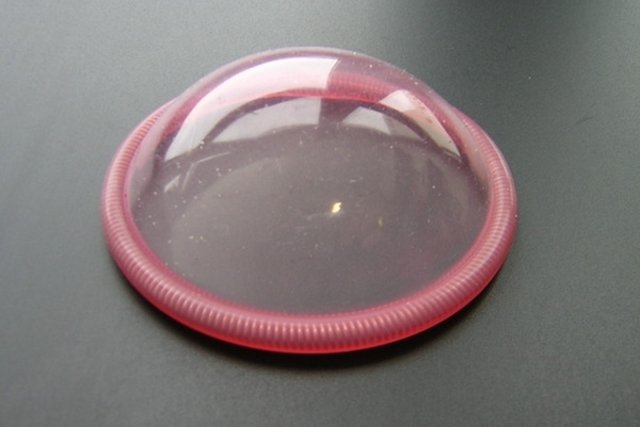The diaphragm is a barrier contraceptive method that aims to prevent sperm from coming into contact with the egg, preventing fertilization and, consequently, pregnancy.
This contraceptive method consists of a flexible ring, surrounded by a thin layer of silicone or rubber, which must have the appropriate diameter for the size of the cervix and, therefore, it is important that the woman consults the gynecologist for the examination to be carried out. of touch and, thus, the most suitable diaphragm can be indicated.
The diaphragm can be used for up to 2 years, and it is recommended to change it after this period. Furthermore, it is recommended that it be placed before sexual intercourse, along with a little spermicidal gel, and removed after approximately 6 to 8 hours of sexual intercourse, to ensure that the sperm do not survive.

How to put
The diaphragm is quite simple to place and should be placed approximately 15 to 30 minutes before sexual intercourse, and it is recommended to always use a spermicidal gel, following the following steps:
- Place the spermicidal gel on the diaphragm and fold it with the round part down;
- Insert the diaphragm into the vagina with the round part down;
- Push the diaphragm and adjust it to be correctly positioned.
In some cases, the woman can add a little lubricant to make it easier to place the diaphragm. After sexual intercourse, this contraceptive should be removed after approximately 6 to 8 hours, as this is the average sperm survival time. However, it is important not to leave it for longer, as otherwise it could encourage infections.
Once removed, the diaphragm must be washed with cold water and neutral soap, dried naturally and stored in its packaging, and can be reused for a maximum of 2 years. However, if there is a hole or crack, it is becoming wrinkled or if the woman becomes pregnant or gains weight, the diaphragm must be replaced.
Advantages of the diaphragm
The main advantages of using the diaphragm are:
- Pregnancy prevention;
- It has no hormonal side effects;
- Use can be stopped at any time;
- It is easy to use;
- It is rarely felt by the partner;
- It can last up to 2 years;
- It cannot enter the uterus or get lost in the woman’s body.
The use of the diaphragm may be recommended by the gynecologist when the woman cannot use the contraceptive pill or has many side effects with its use.
Despite having advantages, using the diaphragm can also have some disadvantages, such as the need to clean it after each use and to change the diaphragm when weight gain, in addition to being associated with a 16% chance of failure and vaginal irritation.
Furthermore, the diaphragm does not protect against sexually transmitted diseases, so if you have several partners, it is best to use a condom to avoid possible infections.
Diaphragm effectiveness
The diaphragm, when placed correctly, is 92 to 96% effective, according to the World Health Organization, which means that between 4 and 8 women out of every 100 can get pregnant within 1 year even with the use of the diaphragm.
However, when the diaphragm is placed incorrectly, its effectiveness can decrease to 84%.
When it is not indicated
The use of the diaphragm is not recommended when the woman has some change in the uterus, such as prolapse, uterine rupture or change in position, or when the vaginal muscles are weaker, as in these cases the diaphragm may not be positioned correctly and, therefore, not be effective.
Furthermore, the use of this contraceptive method is not recommended for virgin women or women who are allergic to latex, and is not recommended during the menstrual period, as blood may accumulate in the uterus, favoring the development of inflammation and infection.
The diaphragm should also not be used when you have a vaginal infection or during the next 6 weeks after giving birth.
Bibliography
- SPANISH ASSOCIATION OF PEDIATRICS. Diaphragm: a contraceptive method. Available at: <https://enfamilia.aeped.es/vida-sana/diafragma-un-metodo-anticonceptivo>. Accessed on May 30, 2023
- RICHARD, Allen. Diaphragm Fitting. American Family Physician. Vol.69. 1.ed; 97-100, 2004
- FACULTY OF SEXUAL AND REPRODUCTIVE HEALTHCARE. FSRH Clinical Guideline: Barrier Methods for Contraception and STI Prevention. 2015. Disponível em: <https://www.fsrh.org/standards-and-guidance/documents/ceuguidancebarriermethodscontraceptionsdi/>. Acesso em 30 set 2021

Sign up for our newsletter and stay up to date with exclusive news
that can transform your routine!
Warning: Undefined array key "title" in /home/storelat/public_html/wp-content/plugins/link-whisper-premium/templates/frontend/related-posts.php on line 12
Warning: Undefined array key "title_tag" in /home/storelat/public_html/wp-content/plugins/link-whisper-premium/templates/frontend/related-posts.php on line 13



